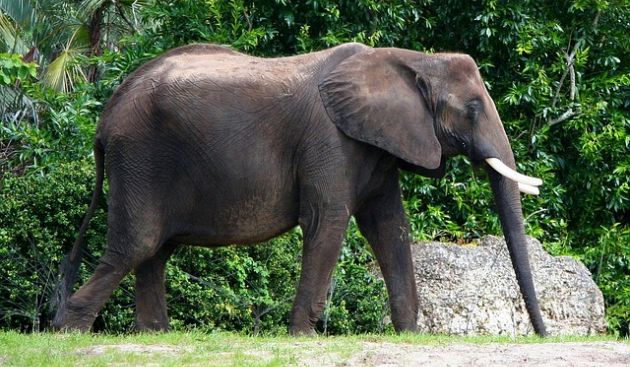
Not in any espionage sense. Rather, my trip to the American Museum of Natural History last week was enlivened, however slightly, by spotting a Rock Pigeon perched on top of the elephants in the Hall of African Mammals, safely out of the elements and unexposed to Central Park’s hawks.
After checking with a docent to make sure that the bird wasn’t a hazard to the collection I watched it for some time – I even tried to take its picture, but the lighting was less than optimal and the camera in my phone somewhat potato-like.
The pigeon seemed very comfortable. I suppose the broad, slightly divoted head of an African elephant in permanent mid-stride is something like the edge of a cliff or the ledge of a skyscraper, a place where the Rock Pigeon would feel at home. What better testament to Carl Akeley, the taxidermist who mounted that elephant and to whom the Hall of African Mammals is dedicated, than to say that he turned a vast, throbbing, stampeding, living animal into an edifice with a feeling so much like permanence that a pigeon could go to sleep there?
Of course it’s not permanent. You need only do a little reading on the history of the museum, or of any museum. For that matter, you need only ramble round a few corners until you find yourself standing before the faded American Redstart or the obscured captions on half the dioramas in the Sanford Hall of North American Birds. Time and chance happeneth to museum specimens. Noble restoration work has been done at the AMNH, particularly to the glamorous megafauna. But in the end, being dead doesn’t protect an animal from mortality.
Taxidermy is a bizarre art. It is driven by love for animals, but relies on their deaths to exist. It is responsible for some of the happiest moments of my childhood, the trips to the Buffalo Museum of Science that kindled my passion for nature; and yet, the quest for specimens ushered some of my favorite species of birds out of the world. When I told the kindly old woman with the cart of skulls for the edification of visitors about the pigeon, I was worried that the living bird would somehow hurt the long-dead elephants, not that it was trapped or going to be contaminated by the preservatives embedded in the pachyderm hide — a bizarre moral calculation to say the least. Akeley himself, or so the legend goes, began his taxidermic career by working on a neighbor’s canary, which had frozen to death in the night, trying to keep her grief at bay…. or maybe showing off. If he was responsible for the deaths of animals in his career (pointing out to Theodore Roosevelt and other illustrious guests exactly which elephants he wanted shot for the exhibit) he also gave his own life in the quest — he died of fever and exhaustion in the jungle where he was making sketches for the gorilla diorama, and never lived to see the opening of the hall that was therefore dedicated to him.
The American Museum of Natural History is a vast and beautiful edifice. It contains Andean Condors and Labrador Ducks, dinosaurs and mammoths, one of only two life-size models of a blue whale in the terrestrial world. And yet the single living pigeon on that elephant’s head was ultimately what I looked at the longest. On the other hand, the people who visit tomorrow will not see it. So what does it really mean?












Leave a Comment